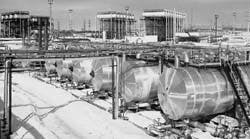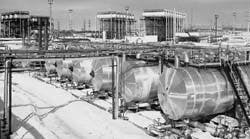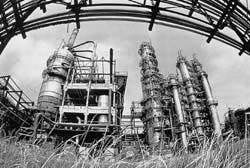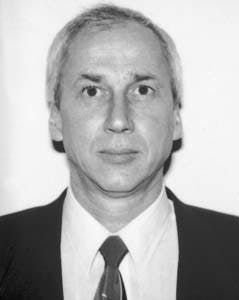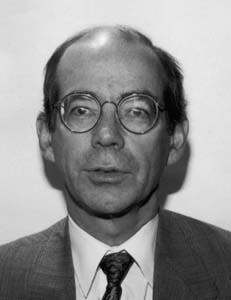FSU'S NATURAL GAS LIQUIDS BUSINESS NEEDS INVESTMENT
Valeri S. Plotnikov, Michael Berman, Gabriel F. Angerinos
Poten & Partners Inc.
New York
Production of natural gas liquids has fallen seriously behind its potential in the former Soviet Union (FSU).
If these hurdles can be overcome, FSU output of liquid petroleum gas alone might double between 1990 and 2010.
In the FSU, LPG is produced from associated and nonassociated natural gas, condensate, and refinery streams. It also comes from what is known in the FSU as ShFLU - a mixture of propane, butane, pentane, and hexane produced at gas processing plants in Western Siberia and fractionated elsewhere.
In Russia, the FSU's main gas liquids supplier, approximate LPG production shares are:
- 40% from the Sintezkauchuk Association, which is responsible for LPG production at petrochemical plants.
- 25% from the Oil Refinery Committee.
- 20% from processing of associated gas by Rosneft and Neftegazpererabotka.
- 15% from processing of nonassociated gas and condensate by Gazprom.
The outlook is good for LPG demand inside and outside the FSU and for exports to world markets. In spite of the FSU's rich reserves of this valuable light hydrocarbon feedstock, however, much is being irrevocably lost. Between 1990 and 1994, LPG production in Russia declined by about 40% to an estimated 5.2 million metric tons.
Russian LPG output averaged about 85% of the FSU total during 1988-94 (Fig. 1). (42970 bytes) Three former republics could produce significant amounts: Lithuania 250,000 metric tons/year, Belarus about 300,000 tons/year, and Ukraine 600,000 tons/year. Even at those levels, however, they would not be self-supporting.
Production of LPG in these republics depends on Russia's production of oil and nonassociated gas and on transportation infrastructure controlled by Russia.
Azerbaijan produces 60,000 tons/year and Georgia about 10,000 tons/ year, not enough to meet internal needs. Countries such as Estonia, Latvia, Armenia, Tajikistan, and Kyrgyzstan, have no LPG production. Kazakhstan, Uzbekistan, and Turkmenistan have significant but mostly undeveloped resources.
Poten & Partners anticipates an increase in LPG produced at refineries in 1995, helping to lift Russian output to 6.5 million tons. If the current downtrend were to continue at Russian plants, LPG production in 1995 would be less than 5 million tons. Production at that level would not even satisfy Russian demand, let alone provide any surplus for export to adjoining countries-the near abroad.
This could lead to loss of markets and increase friction between Russia and its neighbors, since 35 million FSU families, totaling 150 million people, use LPG for cooking. Half of those families are in Russia. LPG has been used in everyday life by millions of families in the FSU for more than 30 years. Finding a quick replacement would be impossible.
The decline in LPG output results from falling production of oil and SHFLU, a halt in plant construction both symptoms of the FSU's deep economic recession - and soaring rail transportation costs.
WEST SIBERIA
Any review of FSU production of gas liquids must focus on West Siberia's Tyumen Oblast, more than 95% of the economy of which depends on the oil and gas industry.
Tyumen Oblast's Yamalo-Nenetsk District provides nearly 90% of Russia's natural gas, while Khanty-Mansiysk accounts for three quarters of the country's oil.
Thirteen crude oil production enterprises operate in Tyumen Oblast. Each collects associated gas at separation units. Sibneftegazpereiabotka (SNGP), formed in 1975, transports gas from the separation units and processes it. SNGP's nine processing plants have total capacity of 28 billion cu m/year (see map, OGJ, Aug. 2,1993, p. 53).
SNGP, which also operates compressor stations, gas collecting pipelines, and gas and product pipelines, delivers SHFLU to transportation companies and dry gas - mostly methane and ethane - to Gazprom's pipeline system. SHFLU moves by pipeline to the Tobolsk petrochemical combine or by railroad to European Russia.
SHFLU production in Western Siberia, including the Surgut gas-condensate plant, grew from nil in 1975 to 4.6 million tons in 1990. It has since fallen by about 25%.
Associated gas makes up a large part of hydrocarbon production in Tyumen Oblast, totaling 28.1 billion cu m-about 30 million tons of oil equivalent-in 1993. Associated gas utilization in 1993 was 23.3 billion cu m, or 83% of production. Official reports state that 4.8 billion cu m of gas was flared, about 17% of production. This appears to be a major improvement from 1980, when about 50% of production was flared (Fig. 2). (33864 bytes)
In fact, there has been no significant improvement since 1990. Furthermore, official statistics understate the extent of flaring. At least 10 billion cu m was flared in 1993.
Despite the apparent leveling off in the portion of gas flared, the situation for gas in general continues to worsen. Poten & Partners believes flaring probably increased in 1994. There has been no construction of plants or gathering pipelines to handle associated gas during the last 4 years due to a lack of central financing.
For example, in the middle of 1993, transporting 1 ton of SHFLU from Tyumen Oblast to the Finnish border cost about $4. In December 1994, transporters were asking as much as $80/ton for the same trip.
The problems of flaring and poor economics would be alleviated if prices were allowed to increase to the world level. To redress the lack of capital, legislative organizations should develop legal and financial structures to encourage Russian and foreign investments. They also should change the tax-price system to make construction of gas processing plants economically attractive.
The outlook for oil production in Russia in the late 1990s is cloudy at best. Even if it continues to fall, however, this may not be the case for associated gas production because of the planned development of new oil fields in the north of Tyumen Oblast. These fields have a higher gas content than those in center of the region. This will increase pressure to reduce flaring.
Planned Associated Gas Processing Facilities, Tyumen Oblast (21370 bytes)
The table shows a list of facilities from the 1992 Russia Fuel and Energy Ministry program that could reduce flaring of associated gas in Western Siberia to 10% of production over 5 years.
The only likely sources of construction financing for this program are foreign investments and currency credits. Repayment of credits may be made through revenues from exported gas liquids. Most of the funds are expected to come from major western organizations, including World Bank and the European Bank for Reconstruction and Development.
Rurhrgas AG of Germany and Gazprom are considering a gas saving project worth more than $1 billion in Tyumen Oblast with SNGP and regional oil producer Purneftegaz. The project could save 6-7 billion cu m/year of associated gas, producing about 5 billion cu m/year of dry gas and 2 million tons/year of LPG.
Purneftegaz would produce the gas, which would be processed by SNGP and transported by Gazprom. According to Ruhrgas, project revenues could reach $5 billion over 20 years.
PRODUCTION OUTLOOK
The FSU's gas liquids resource is clearly underutilized.
Based on resources, Poten & Partners estimates the production potential for LPG in West Siberia alone at about 20 million tons/year, of which 9 million tons could come from Urengoy and its surrounding fields.
In Kazakhstan, Turkmenistan, and Uzbekistan, where gas processing and refinery technology similar to that in Russia is used, there is also great potential for increased recovery of gas liquids, subject to resolution of utilization and transportation issues.
Although expectations have become more realistic than they, were before throughout the FSU, the economic situation makes development of LPG production more important than ever. According to a World Bank forecast, after the mid-1990s oil production will stop declining, and gas production will level off in the FSU. Legal and financial organizational structures will be one of the main factors for encouraging private investments, at first from foreign countries and by 2000 from internal financing.
According to Poten & Partners' current outlook total LPG production in the FSU could climb to about 20 million tons/year by 2010 from 10.5 million tons in 1990 if capital becomes available for required investments.
Nonassociated gas could account for about 3 million tons of the increase, associated gas-including fractionation plants-about 4 million tons, and refineries about 2 million tons.
The projected production increase from associated gas at gas processing plants represents growth of more than 80% between 1990 and 2010. It depends on fractionation capacity increases at the Tuimazinsky, Shkapovsky, and Permsky plants; installation of LPG production capacity at Otradnensky, Neftegorsky, Zhanazholsky, and Tengizsky; and installation of new units in West Siberia and by Orenburg Joint Stock Co. (Onaco) at Orenburg.
Poten & Partners estimates LPG production from gas processing plants based on nonassociated gas could be 4 times the 1990 level by 201 0. By then it may be possible to produce not just ethane and SHFLU from natural gas and condensate processing but also nearly 4 million tons/year of LPG. Growth in production of LPG at nonassociated gas processing plants depends mainly on the construction of facilities by Gazprom.
LPG production at refineries is expected to increase by about 70% between 1990 and 2010. This output serves traditional (household) markets as well as transportation and petrochemical sectors.
The projection for petrochemical plant production of LPG assumes increases in existing fractionation capacity of 750,000 tons/ year at Sintezkauchuk's Tchaikovsky plant, 2.2 million tons/year at Nizhnekamskneftekhim, 1 million tons/year at Salavatnefteorgsintez, and 4.5 million tons/year at the Tobolsk petrochemical combine and a revamping of the fractionation unit at the Novokuybyfhevsk petrochemical combine.
LPG USE
Just as production of LPG in the FSU is being constrained by lack of investment, so is consumption. Investments must be made in the petrochemical and other industrial sectors to strengthen the economies of FSU countries. These in turn will increase LPG demand (Fig. 3). (32942 bytes)
Most LPG demand in the FSU is in traditional uses such as household heating and cooking. This sector accounted for almost half of total LPG use in 1990.
Petrochemical use of LPG, the second largest market, accounted for one third of 1990 demand. The rest of LPG demand was for auto fuel, metal cutting, and other industrial applications.
The petrochemical industry uses LPG mainly for production of olefins, through thermal pyrolysis, and of monomers for the synthetic rubber industry. Poten & Partners projects the petrochemical industry's demand for LPG to increase by almost 40% between 1990 and 2010.
Nonchemical demand for LPG is expected to grow about twice as fast. Traditional demand will continue to be the largest consuming sector, but its growth will be relatively slow. By contrast, auto fuel use of LPG is expected to almost quadruple by 2010.
Metal cutting and other industrial applications will more than double, and exports could increase five-fold, but from smaller base levels.
BUSINESS DEVELOPMENT
With domestic capital insufficient to meet requirements of the FSU oil and gas industry and leave resources for other sectors of the economy, foreign funds are vital for development of the LPG industry. Participation by foreign companies also can foster the transfer of technology and reduce risks borne by producers.
The main stumbling blocks to successful foreign investment have been the evolving political structure and the unfamiliarity of authorities with methods for attracting capital other than simply declaring the need and expecting it to be met.
Certainties provided by contracts elsewhere in the world are not perceived to exist in the FSU because of the political changes. The special tax on funds entering Russia proposed last year was a spectacular example of the lack of knowledge about how to encourage capital to flow into the country.
But this is a two-way street. Non-FSU companies have to convince the people, enterprises, and governments of the FSU that their investments will contribute to development and not merely to removal of resources and enrichment of others.
Many questions face the investments necessary to the FSU's potential doubling of LPG output by 2010. For example:
- Would there be transportation at competitive prices to provide acceptable returns to producers and investors?
- Could the business environment and FSU legislative bodies allow repatriation of profits made in different operations to provide the basis for investments in Russia and elsewhere in the FSU?
- Will investment be made to enable the use of nonassociated and associated gas?
In view of the vast resources of Russia, Kazakhstan, Turkmenistan, and Uzbekistan, the countries of the FSU should not need to import LPG from anywhere else. Yet in West Siberia, the flaring of 8-10 billion cu m/year of associated gas wastes 3-4 million tons/year of LPG. This volume is sufficient for traditional supply to near abroad countries.
The bottleneck to realization of the market potential of LPG is lack of investment for production and transportation.
It is generally accepted that provision of a favorable investment climate plays a key role in development of the oil and gas industry. Many Russian and western analysts-including Poten & Partners-are convinced that the effectiveness and vitality of the FSU legal system will grow.
New legislative documents should contain regulations guaranteeing stability for foreign and Russian investors.
THE AUTHORS
Plotnikov worked for 18 years with the biggest associated gas company in West Siberia, Sibneftegazpererabotka. He is the author of several publications on the Russian oil and gas industry and on creation of market conditions in the economy.
Berman has a BS in chemistry from the University of Wisconsin. He is a former member of the supply and demand committee of the Independent Petroleum Association of America.
Avgerinos is active in several projects involving investment in or construction of LPG and gas processing plants in the former Soviet Union. He has a BS in chemical engineering from the Polytechnic Institute of New York, an MS in chemical engineering from Massachusetts Institute of Technology, and an MBA from the London Business School and Haute Etudes Commerciales, Paris.
Copyright 1995 Oil & Gas Journal. All Rights Reserved.
